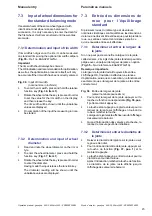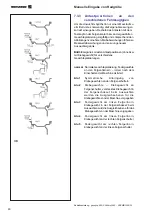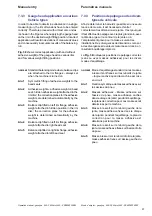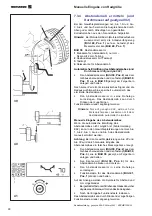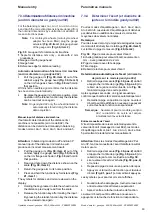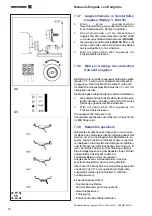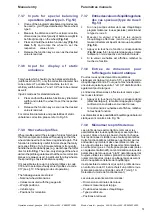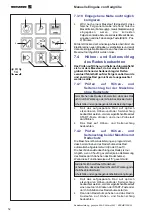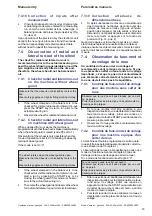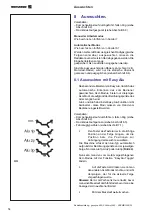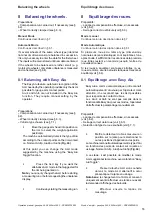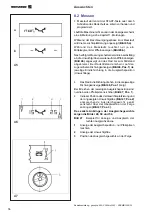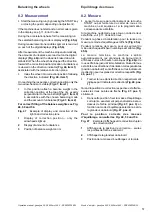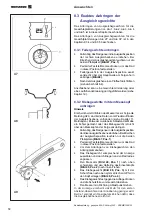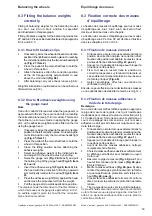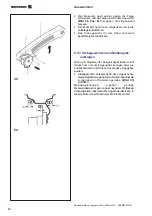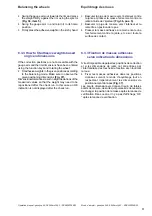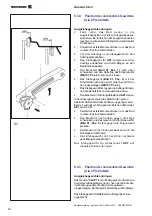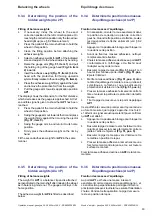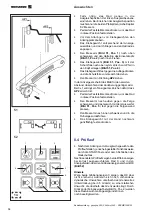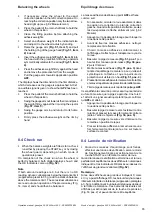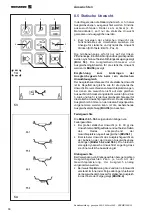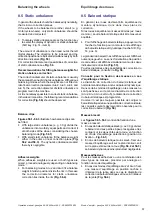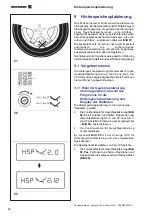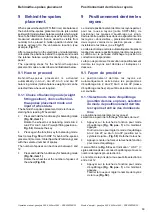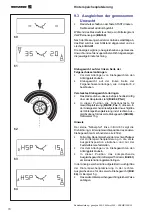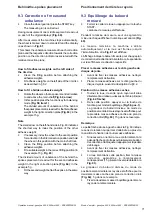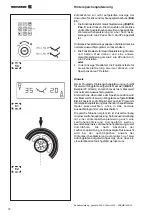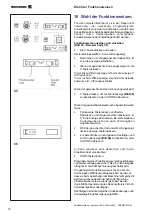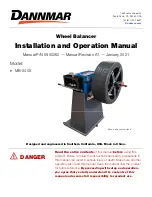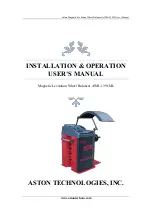
59
Equilibrage des roues
Mode d’emploi - geodyna 990-2,990mot,992 - ZEEWB724B03
Balancing the wheels
Operation manual - geodyna 990-2,990mot,992 - ZEEWB724B03
8.3 Fixation correcte des masses
d’équilibrage
La fixation des masses d’équilibrage pour les modes
d’équilibrage nor., Alu 1, Alu 2, Alu 3, Alu 4 et Alu 5 est
décrite et illustrée dans cette chapitre.
La fixation des masses d’équlibrage pour les modes
d’équilibrage Alu 2P et Alu 3P est décrite et illustrée
dans les chapitres 8.3.4 et 8.3.5.
8.3.1 Fixation de masses à ressort
y
Si nécessaire, orienter la roue exactement dans la
position de correction du plan de correction droit.
Quand cette position est atteinte, seules les deux
pointes de flèche s’allument
(Fig. 47, pos. 2)
.
y
Appuyer sur la pédale de blocage pour bloquer la
roue dans cette position.
y
Fixer la masse à ressort dans la position de
correction respective sur le rebord de la jante, et
ce sensiblement perpendiculaire à et au–dessus
de l’arbre principal.
(Fig. 48)
.
y
Après l’équilibrage, effectuer une lancée de
vérification (voir § 8.4).
Ensuite, on peut effectuer une minimisation des masses
ou une optimisation de stabilité de marche (voir § 12.).
8.3.2 Fixation de masses adhésives à
l’aide de la tête de pige
Remarque
Si un code d’erreur H20 est affiché quand on approche
la pige de mesure de la jante, c’est qu’il n’existe pas
de données pour retrouver le plan de correction (voir §
11. Codes d’erreur). Soit une erreur a été commise au
cours du palpage des dimensions, soit la masse
adhésive ne doit pas être fixée sur la jante au moyen
de la tête de pige.
y
Si nécessaire, orienter la roue exactement dans la
position de correction du plan de correction gauche.
Quand cette position est atteinte, seules les deux
pointes de flèche s’allument
(Fig. 47, pos. 1)
.
y
Appuyer sur la pédale de blocage pour bloquer la
roue dans cette position.
y
Avant de fixer les masses adhésives, nettoyer
l’emplacement de fixation.
y
Choisir la masse adhésive destinée conformément
à l’affichage et la fléchir pour l’adapter au rayon
de la roue.
y
Basculer la pige de mesure
(Fig. 49, pos. 1)
en
haut et tirer l’anneau porte-masse
(Fig. 49, pos.
2)
vers l’intérieur.
y
Mettre la masse adhésive
(Fig. 49, pos. 3)
dans
la tête d’équilibrage symétriquement à la flèche
et que la pellicule de protection soit visible d’en
haut
(Fig. 49, pos. 4)
.
y
Presser la masse adhésive fermement contre la
tête et enlever la pellicule de protection de ladite
masse.
y
Tirer la pige de mesure vers le point de palpage.
Il sera affiché la valeur du premier écart qui se réduira
au fur et à mesure que la pige s’approche. Une fois 0 1
atteint, un signal acoustique confirme que le plan de
correction est atteint.
8.3 Fitting the balance weights
correctly
Fitting of balancing weights for the balancing modes
nor., Alu 1, Alu 2, Alu 3, Alu 4, and Alu 5 is specified
and illustrated in this paragraph.
Fitting of balance weights for the balancing modes Alu
2P and Alu 3P is specified and illustrated in paragraphs
8.3.4 and 8.3.5.
8.3.1 How to fit balance clips
y
If necessary, index the wheel to the exact correction
position in the righthand correction plane. On reaching
the correction position only the two arrow-heads light
up
(Fig. 47, item 2)
.
y
Press the pedal of the main shaft lock to hold the
wheel in this position.
y
Attach the balance clip in the correction position
at the rim flange exactly perpendicular to and
above the main shaft
(Fig. 48)
.
y
After balancing carry out a check run (see § 8.4).
Weight minimisation or optimisation can be carried out
afterwards (see § 12.).
8.3.2 How to fit adhesive weights using
the gauge head
Note
If an error code H20 is read out when the gauge arm is
approached to the rim, there are no data for re-locating
the correction plane (see §11. Error codes). This means
that either an error was made in applying the gauge
arm, or the adhesive weight cannot be fitted on the rim
using the gauge head.
y
If necessary, index the wheel to the exact correction
position in the left correction plane. On reaching the
correction position only the two arrow-heads light
up
(Fig. 47, item 1)
.
y
Press the pedal of the main shaft lock to hold the
wheel in this position.
y
Clean the fitting position before attaching the
adhesive weights.
y
Select an adhesive weight of the indicated size
and adjust it to the wheel radius by bending.
y
Raise the gauge arm
(Fig. 49, item 1)
and pull
the holding ring of the gauge head
(Fig. 49, item
2)
inwards.
y
Insert the adhesive weight
(Fig. 49, item 3)
into
the head with the protective foil facing upwards
symmetrically relative to the arrow
(Fig. 49, item
4)
.
y
Press the adhesive weight firmly against the head
and remove the protective foil from the weight.
y
Pull the gauge arm towards application position.
The display shows the dimension for the first distance,
which decreases as the gauge is approached. At 0 ±1
an audible signal is given to show that the correction
plane has been reached.

